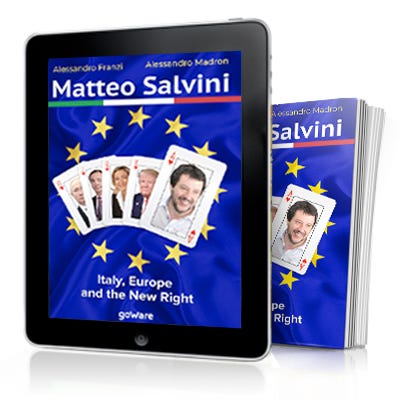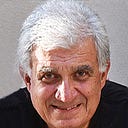Who is Matteo Salvini?
A new book is trying to answer
Vai agli altri articoli della serie “La società liberale e i suoi nemici”

We are pleased to publish two short excerpts from the book, Matteo Salvini. Italy, Europe and the New Right by Alessandro Franzi and Alessandro Madron (goWare, 2019). It was recently published in English in an updated, and enlarged edition. Alessandro Franzi, a journalist, he has written about politics for the agency Ansa in Milan and currently works in the Rai newsroom in Trento. Alessandro Madron, journalist and videographer, is part of the staff of “Il Fatto Quotidiano”, where he writes about the transformation of the Lega.
Matteo Salvini is one of the most controversial up-and-coming figures on the European political scene. Since 2013 he has been the leader of Italian Lega — formerly a secessionist party which he himself transformed into the champion of the new nationalist and sovranist right, swinging between Putin and Trump. In 2018 he became both the Vice-Prime Minister and the Minister of the Interior of Italy in a coalition government with the populist Five Star Movement.

Accused of racism and neo-fascism, Salvini has built his success on the social disorientation created by globalization and on the fear of immigration, using an aggressive and irreverent media campaign. But it’s also thanks to his political ability, developed during his long militancy in the party, which began when he was 17 years old, that he was able to recognize before others the new spirit of the times. According to most people, after the election in 2018, Salvini had in reality become the leader of Italian politics, with the goal of heading the nationalist front in Brussels after the European elections in May of 2019, and then, the next Italian government.
The book by Franzi and Madron, two Italian journalists who cover Salvini since the beginning, is a map that seeks to answer one simple question: who is Matteo Salvini, really? A terminator? A knight of the apocalypse? A fascistoid? Or trivially a camaleont? Italy is a good environment for this kind of political animals.
Matteo Salvini. Italy, Europe and the New Right
By Alessandro Franzi, Alessandro Madron.
98 pp. goWare.
Amazon: Paperback $11.99, Kindle edition $5.57.
Translated from Italian by Katherine Perunic.

The gut
For years commentators were busy trying to understand if Salvini represented a political bubble, overblown by an excessive tv presence, or a phenomenon destined to last and make a deep mark in Italian politics. Probably one argument upheld the other, in keeping with the spirit of the times.
From 2014 to 2018 the leader of the Lega rose in the polls thanks also to his massive television presence and his ability to intercept public sentiment. He had always known how to tug on the heartstrings of the masses by using his performances on tv effectively. His declarations would quickly become breaking news in the general media circus, dominated by his agenda: safety, immigration, Euroscepticism.
Usually, the press agencies begin to release news. Then websites post fragments of video or audio that gets the discussion started. The political adversaries attack. And on social media the comments become a battle, in which only the most ruthless win.
“The Lega is gaining ground by choosing to use violent language? It’s a problem between form and substance,” was Salvini’s response. “What interests me is the substance of civil coexistence. If the term bulldozer starts a debate on whether there should be Roma camps, getting even a lot of left-wingers to say that the Roma camps no longer make sense, then it means that I did well to use the term bulldozer.”
Many people would have bet that at some point it would reach a saturation point, but Salvini’s success did not cease. Salvini had probably filled a void that no one else had been able to do in Italian politics: the void left by Bossi in the Lega, the void left by a declining Berlusconi in the center-right, the void made by the left-wing parties who had come to be considered elitist.
A constant growth, which brought Salvini to the government with an unimaginable consensus for the Lega as a party from the North. Even after the 2018 elections it continued: in early 2019, the nationalist party was at 30% in the polls, after the 17.4% it had tallied in the election.
The brand Salvini got bigger and bigger. It monopolized the news media, radio and tv shows. It became the object of impressions and political satire, where the boundary between political culture and pop culture can’t be distinguished.
In uniform

In short, Salvini proved to be a great chameleon. From pro-independence to nationalist, from communist to reactionary idealist, he adapted to every communication platform, blending in with the common language. And even changing his camouflage constantly.
He was Milanese in Milan, Palermitano in Palermo, Roman in Rome, a police officer among the police, a firefighter with the firefighters. Salvini even used his clothing as a distinctive political tool.
Sweatshirts with the name of the place where he was speaking, together with his earring, were distinguishing elements when he appeared in public throughout his political rise. Every piazza, every rally, had its sweatshirt. It was a way to tell the people: “I am one of you.” An article of clothing associated with youth, but also used by older people during their free time, which had never been flaunted as a sign of leadership.
Another barrier eliminated, a fashion tool used to create identity and reassurance in a lighthearted way.
The leader of the Lega had always been allergic to formality, wearing a tie only when it was absolutely necessary. Therefore, even as Vice-Prime Minister and Minister of the Interior his wardrobe became a subject of debate, and not only for his casual clothing.
Salvini is in fact known for wearing law enforcement uniforms. A media game, but also a message to the electorate, which has elicited applause and indignation, in a country that experienced the violence of Mussolini’s regime.
The most critical voice against Salvini was once again that of the writer Roberto Saviano, who lives under protection as a result of the death threats he has received from organized crime members. In an article published by Repubblica on January 11, 2019, Saviano compared the attitude shown by Salvini in uniform to that of leaders like Castro, Gheddafi, Stalin and of course Mussolini. “Wearing a uniform means sending a dangerous message for democracy and it’s like saying: the police is mine. But that’s not the case,” wrote Saviano.
Disparaging, as usual, Salvini’s reply on Twitter was: “Poor Saviano, he doesn’t know what to invent anymore! Kisses.”
Giuliano Ferrara, a journalist who in 1994 had even been a minister in the Berlusconi-Bossi government, began calling Salvini “Il Truce”, playing on its rhyme with Il Duce, and accusing him of “racism”.
“Salvini is dressed even when he is naked, he doesn’t have a body, he’s more like a mannequin, because he doesn’t have the physique of a leader,” asserted Marco Belpoliti, who teaches at the University of Bergamo and has studied the message that leaders’ bodies deliver. According to Belpoliti, “Salvini gets dressed and dresses up, because transformation is an essential part of his nature.”
“From the billboards on the street to the banners on the web, from Facebook to Twitter,” the academic continues, “it is all a succession of promotions, invitations to purchase something, commercial suggestions and offers. Why should it surprise us if Salvini shows up at a rally or a speech wearing a shirt with a slogan on it? The photographers will immediately take their snapshots and the next day the text will be all over social media and newspapers, for everyone to read. But Salvini doesn’t have anything to say, that’s why he needs to show off a written surface.”
Alessandro Franzi is a journalist. He has written about politics for the agency Ansa in Milan and currently works in the Rai newsroom in Trento. Since 2004 he has focused his attention on the Lega Nord and the eurosceptic movements. Born in 1981 in Varese, where he began writing for the newspaper “Il Giorno”, he has a degree in History. He has published several articles on the LSE blog “Euro Crisis in the Press”.
On Twitter he is @ilbrontolo.
Alessandro Madron is a journalist and videographer. Born in 1978 in Castiglione Olona (Varese), he spent 10 years working as a reporter for local newspapers in his province, the cradle of the Lega. Since 2011 he has been on the staff of “Il Fatto Quotidiano”, where he has written about the transformation of the Lega. In 2012, Editori Internazionali Riuniti published his books: Maroni, una vita da mediano and Roberto Maroni. Barbaro o sognatore? I segreti dell’ascesa di un leader. You can find him on Twitter @alemadron.
